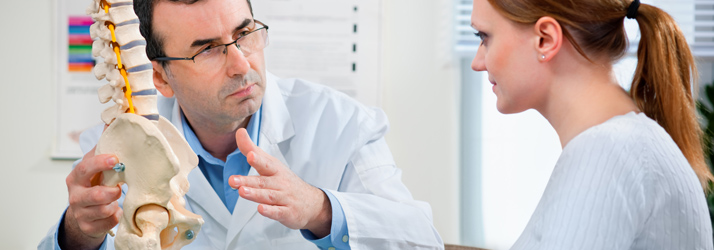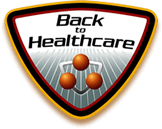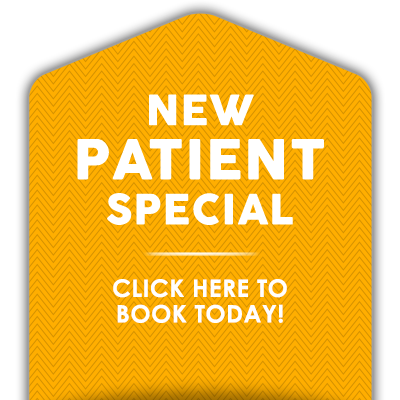Natural Treatment for Herniated Disc Pain and for Slipped Disc Pain in Torrance?

Written by Dr. Brad Barez, CCSP, QME, IDE.
Looking for the best Torrance chiropractor? Contact Back to Healthcare Chiropractic to see how they can help you get back to living a pain-free life.
The Spinal Anatomy Explained by your Torrance chiropractor:
Between each of the vertebral bodies is a cushion called the intervertebral disc. Each disc acts as a shock absorber for the stresses of the body during movement and protects the spinal cord and nerve roots. The intervertebral discs are the largest structures in the body with a very limited vascular supply or blood supply.
Each disc is made of two parts: the annulus fibrosus and the nucleus pulposus:
- Annulus Fibrosus
The annulus fibrosus is a tough structure that is covered by a gel-like center, the nucleus pulposus. The annulus allows the spine’s rotational stability and helps to resist stresses.
The annulus is a layered structure consisting of 90% water and sturdy elastic collagen fibers. The fibers are oriented at different angles horizontally similar to the construction of a radial tire. Collagen consists of fibrous bundles made of protein-bound together by proteoglycan gel.
The intervertebral discs are the largest structures in the body without a vascular supply. - Nucleus Pulposus
The center portion of each intervertebral disc is filled with a gel-like elastic substance. Together with the annulus fibrosus, the nucleus pulposus transmits stress and weight from vertebra to vertebra.
The structural components of the nucleus pulposus are similar to the annulus fibrosus: water, collagen, and proteoglycans. The difference is the concentration of these substances. The nucleus contains more water than the annulus. - Endplates
The top (superior) and bottom (inferior) of each vertebral body is coated with an endplate. Endplates are complex structures that blend into the intervertebral disc and help hold the disc in place.
Disc Herniation: “Slipped” and “Bulging” Discs
Discs are firmly embedded between the vertebrae and held in place by ligaments connecting the spinal bones and muscle. There is little room for discs to “slip.” A “bulging” or herniated disc, however, can occur when gel or fluid pushes out through a crack in the exterior. This can irritate nearby nerves and result in pain, numbness, or weakness in an arm or leg. Many people, however, experience no symptoms from a herniated disc.
There are two types of herniated discs: protrusions and prolapses. A protrusion can occur if the disc bulges, pushing it out of shape. A prolapsed disc is one that bulges out so much; it actually separates from the rest of the discs. In this scenario, if the disc pushes on the spinal cord or puts pressure on nerves, it causes severe pain that makes regular daily activities such as sitting, standing, walking, lifting, using the bathroom, sneezing, or coughing very difficult. Foot or leg numbness or a loss of muscle control may also occur. Only a small number of those with low back pain have serious disc problems.
What is a Spinal Disc?
Spinal discs are sensitive, spongy pads found between the specialized bones (called the vertebrae) of the spinal column. Also called intervertebral discs, each is a flat, circular capsule about an inch in diameter and one-quarter inch thick. Discs have tough outer membranes (the annulus fibrous) and elastic cores (the nucleus pulposus). Their main functions are to act as shock absorbers for the spine during movement and to hold the highly pressurized spine center in place.
As children, the spinal discs are fluid-filled sacs that start to solidify as part of the normal aging process. By early adulthood, the blood supply stops and the soft inner material hardens. By middle age, our discs are hard, almost like a piece of hard rubber. This is why adults are prone to disc injury and degeneration.
Signs and Symptoms:
Below are signs of potential spinal disc issues:
- Tenderness or stiffness of spine.
- Leg, buttock, foot pain.
- Shoulder, neck, or arm pain with certain movements.
- Numbness, tingling, or weakness in body parts served by affected nerves.
Chiropractic Treatment:
Chiropractic care is a safe and effective way to treat herniated and bulging disc problems. By utilizing a comprehensive report of the patient’s history, performing a physical examination, and potentially taking digital images, a chiropractic doctor will diagnose what type of disc problem may be occurring. In some cases, your chiropractor may need an MRI to be able to prescribe a suitable treatment plan specific to your needs including adjustments and therapeutic exercises. In many cases, surgery and injections should be considered your last option due to the risks and side effects involved.
There are many different types of herniated disc pain. There is acute back pain, which is a pain in the low back that occurred within six weeks. Acute herniated disc pain can be moderate to severe in nature. Next, there is chronic herniated disc pain. This is pain that lasts more than 12 weeks and is about 20% of the back pain seen today. Patients with back pain could have associated numbness, loss of motion, burning, or even tingling sensations. Most people think is normal to have this type of pain. However, pain is not normal. Pain is the body telling you there is something wrong. When people get herniated disc pain, this indicates there is pressure building on nerves.
The Problem Causing Herniated disc pain:
Herniated disc pain is usually caused by one of two mechanical structures interfering with these lumbar nerves. The most common cause of herniated disc pain is a vertebral bone compressing directly on one or more of the spinal nerves. When a patient compresses these nerves beyond their pain threshold, the body will elicit a symptom such as herniated disc pain. This problem is called the subluxation complex. The second most common cause of herniated disc pain is a spinal disc compressing on one or more of the spinal nerve roots mentioned above. When the spinal disc compresses the nerves hard enough to pass pain thresholds, herniated disc pain will develop. Remember, the ONLY way a spinal disc can compress or be unbalanced is if the vertebrae above and below the spinal disc are misaligned, therefore compressing one or more of the above nerves.
divider
The Safe Solution to Herniated disc pain:
Finding a good Chiropractor to treat the cause of herniated disc pain is very important. Most treating Doctors treat the symptoms of herniated disc pain, which causes long-term problems and at best temporary relief. A good Chiropractor will identify where the compression or interference of the nerve is using Chiropractic, orthopedic, neurological, and x-ray testing. Sometimes an MRI will need to be performed. Most examinations take between 30-60 minutes for good results.
Next, once the cause of the interference of the sciatic nerve is found, a good Chiropractor will use gentle Chiropractic manipulation to decompress the nerves that are causing the problems. Usually, relief is very fast. If the problem has been developing over a period of time, it could take a couple of months to recover. Additionally, Chiropractors work with the soft tissue around the spine using various physical therapy techniques, and functional stretching and strengthening exercises.
The Hidden Danger of Herniated disc pain Treatment:
Most people know when a sensory nerve is compressed hard enough. When a sensory nerve is compressed beyond their pain threshold, they will feel symptoms. When spinal nerves are compressed, most of the compression of these nerves control “autonomic function.” For example, when patients compress one or more of the spinal nerves in the lower spine, immediately this shuts down the life to the organs such as the reproductive organs, bladder, and prostate of a male. Patients may or may not ever feel the effects of these organs functioning less until it is too late.
The danger of treating herniated disc pain with pain medication is that the inhibition of these nerves is dangerous to the body. When spinal nerves are compressed physically, the solution should be to physically decompress these nerves. Medications inhibit the spinal nerves, therefore allowing a patient to feel better, but the problem remains the same and will get worse over time. The real solution is to physically decompress these nerves as much as the body will allow. This will not only make patients feel better but will restore normal function back to the body.
The New Patient Offer
Back to Healthcare Chiropractic has been treating herniated disc pain safely and effectively since 1994. Even before 1994, the owner’s mom was a Registered Physical Therapist trained out of UCLA who was treating herniated disc pain with great success. Our practice has a systematic way of treating herniated disc pain or sciatic nerve pain using advanced, but gentle Chiropractic techniques, and proprietary Physical Therapy techniques.
Our patients love using the new patient offer. They get a history, examination, report of findings by the Doctor, and x-rays if needed for a very affordable price. We do take most insurance, but we found most chose to pay out of pocket to avoid deductibles and the various insurance limitations. At Back to Healthcare Chiropractic, we always make getting healthy affordable.
Monday
8:30am - 6:00pm
Tuesday
2:00pm - 6:00pm
Wednesday
8:30am - 6:00pm
Thursday
8:30am - 12:30pm
Friday
8:30am - 6:00pm
Saturday
8:30am - 12:30pm
Sunday
Closed
Back to Healthcare Chiropractic
23377 Hawthorne Blvd
Torrance, CA 90505
P: (310) 371-3134
F: (310) 371-6634


